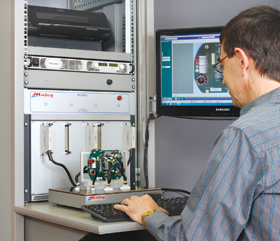

As test and measurement technology has advanced to keep pace with the evolution of the electronics industry itself, the test setups used by engineers and technicians have become almost as varied as the very products they
are designed to test. From the clutter of multimeters and oscilloscopes seemingly strewn randomly across a workbench, to the pristine glory of a state-of-the-art test rack, these setups fall into two broad categories: generic and custom.
As to which is better, the answer lies in the essence of the very old argument of man versus machine, a concept that eventually fuelled the industrial revolution. When it comes to testing printed circuit boards (PCB), subsystems or complete systems, the two most important criteria for test results to comply with are accuracy and repeatability.
These are easily achievable with an automated tester: with the push of a button, one device under test (DUT) after another can be tested. Because results are stored in a database, reports can be used to identify failure trends and improve quality management processes.
When done manually, operators or technicians can get tired or skip tests, misinterpret tests or results, use instruments that might not be calibrated, have different resolutions, record results incorrectly, feed results into a system incorrectly, etc.
The bottom line is that humans get tired or sick; machines do not. Showing an operator which button to push is easier than training an operator through an entire test procedure. Automated testing per DUT is typically much shorter than manual processes and results in much higher output per shift.
Cost effectiveness
In markets where products are price sensitive or have short life cycles, volumes are an important driver in selecting between automated or manual testing. However, in the defence and aerospace industries, volumes are less of a factor because accuracy, reliability and quality of products are paramount; therefore the choice usually goes the way of automated testing.
Irrespective of which industry or what the scenario, all companies are faced with the challenge of time to market. There is never enough time between the product development phase and production to also develop an automated test solution. On the other hand, a reusable (generic) test system consisting of a set of instruments backed by user-friendly software will provide an environment which could already be used interactively during the development phase of a product.
A simple interface, such as a harness, to the product can be developed quickly. Using easy-to-implement test sequences that are saved in the software’s database, the engineer, whilst verifying the design, is at the same time creating the core of the test sequences to be used during production. This effectively shortens the time to get a test system ready for production.
Customers following this approach would then place either an exact replica or a scaled down configuration, consisting of only the required parts from the generic test system, at the production house. Although this requires relatively high capital layout initially, cost savings are achieved over the long term through standardisation and improved turnaround times.
Software is the backbone
Software is a vital part of any automated test system, starting with writing the tests, to storing and managing results, and reporting. If one believes that ‘whatever you can measure you can manage’ rings true, then this certainly applies in the case in measuring test results and understanding failures through reporting and analysis.
The core of the software with the instrument drivers must be in place to make a system highly re-usable. If the engineer is able to implement test sequences with ease it becomes an integrated part of the design and verification processes.
In the production environment, reporting assists in pointing out numerous problems which could relate to either a certain batch of components being faulty or a certain part of the assembly process not conforming to specification.
Generic systems can still be powerful
In developing MultiMac, Mateq’s own generic test system, the company considered all of the above factors and based the concept on providing engineers with a single environment that allows for quick turnaround times when developing tests for a variety of devices, with ease of maintenance and cost effectiveness over the long term.
The building blocks of a MultiMac test system are:
* A computer workstation executing the TestDirector application software.
* A MultiMac controller which consists of a variety of configurable instruments (see accompanying image).
* An interface to the DUT via a dedicated harness or, if required, an adaptor housing any specific electronics.
Provision is made to easily integrate additional hardware such as an RF spectrum analyser, XJTAG, power supplies and signal multiplexers. Test functionality can easily be expanded with the addition of external software through a standard interface.
To do fault finding, automated testing can be stopped when a failure occurs. The instruments can then be controlled with ease to continue with manual testing.
The software provides excellent traceability between the customer’s test specification and the associated test sequence, making it easy to update test limits when requirements change.
To complete its generic test system offering, Mateq also offers interface development, test sequence development, software development, maintenance and support, training and calibration services. The company also assists customers in developing generic or custom solutions, based on National Instruments’ PXI hardware using Labview and TestStand for the software.
Conclusion
Companies should consider test solutions as a strategic decision. This often means bringing different departments and projects together to get a good understanding of which test instruments would best fit their complete range of products. The synergies that are found in the mainstream development of core products usually complement each other and that is where the best solution will come together.
| Tel: | +27 12 665 1770 |
| Email: | [email protected] |
| www: | www.mateq.co.za |
| Articles: | More information and articles about Mateq Systems |

© Technews Publishing (Pty) Ltd | All Rights Reserved